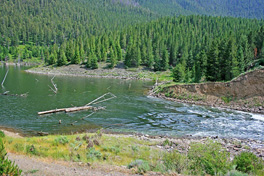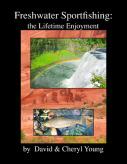Cliffs
Cliffs are great vantage points to look for weed beds; drop-offs, channels and shoals. Cliffs afford shade, more favorable water temperatures and collect float some which includes drowned or struggling aquatic and terrestrial insects. Some cliffs furnish seepage of spring water; furthermore, this enhances more favorable temperatures.
Fish occasionally mill about cliff areas focusing their attention to the surface. Wind-swept insects may hit the cliff and end up in the water. An errant breeze may blow a terrestrial off a ledge into the water. Commonly, food sources come from the surface in cliff areas; similarly, they can be fertile places to fish dry flies.
Cliffs may not be high ones to be productive. Snow banks can serve as temporary cliff-like areas. Rocky shorelines are common in both reservoirs and

in some natural lakes. These shoreline areas fish well with terrestrials. Drift lines of wind blown objects commonly gather at cliffs and rocks. These rocky shorelines are similar to cliffs. An earth filled dam provides an ideal rocky shoreline. It is adjacent to a steep drop off. These drift lines harbor many dead adult and stillborn insects.

© 2025 The Gale Group, Inc. All rights reserved.
© 2025 Perigee Learning LLC. All rights reserved.
LoveTheOutdoors.com is owned and operated by Advameg, Inc. © 2025 Advameg, Inc.
Camping Adventures • Dutch Oven Cooking • Sports Knots
Fly Tying • Freshwater Fishing • Fly Fishing

